*This post may contain affiliate links. Read more »
You can find Martabak on the streets of Jakarta, Singapore, and Kuala Lampur. But this recipe is shockingly fluffy, and by some miracle, it just happens to be completely vegan too!
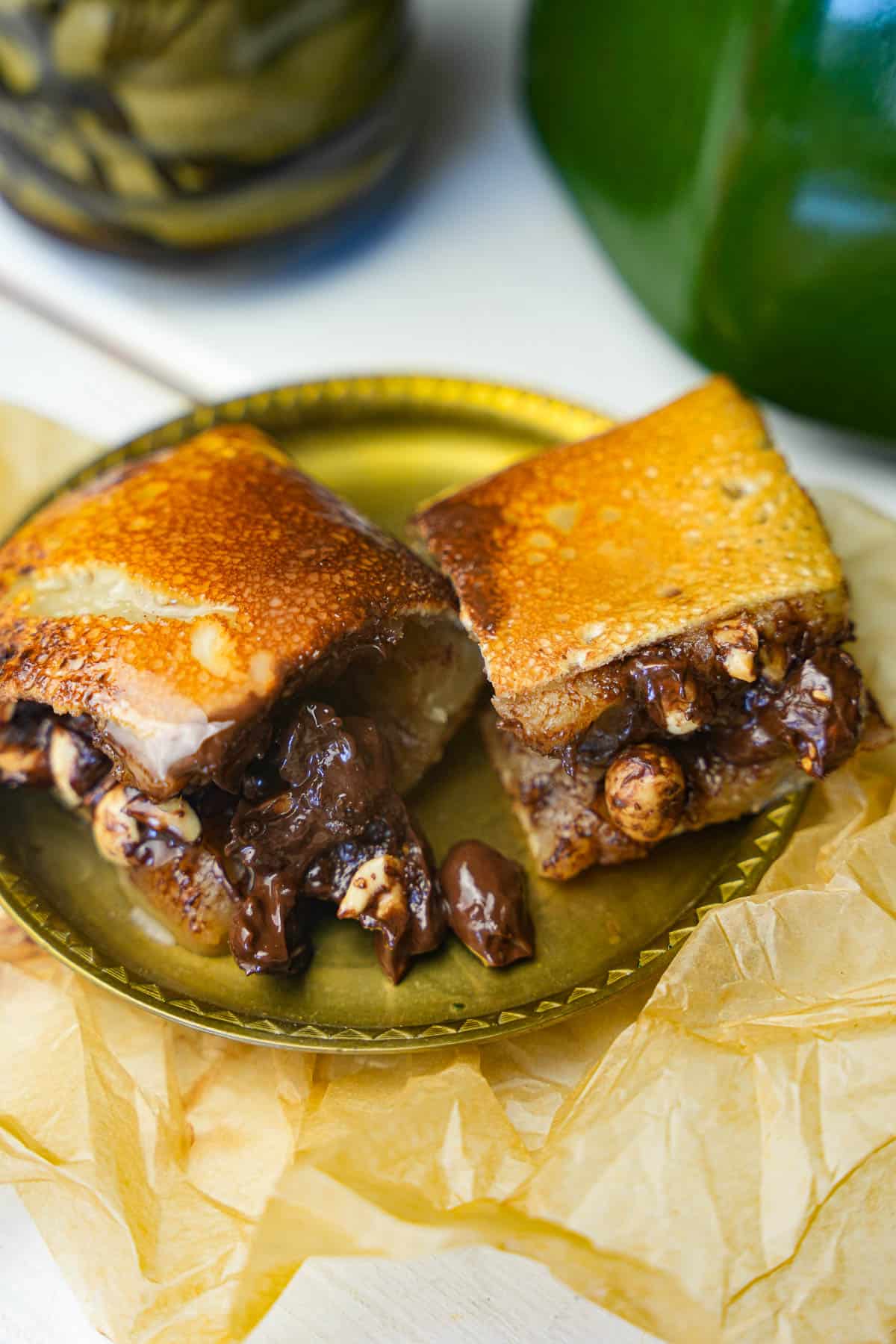

Enter your email & I'll send it to your inbox. Plus, get great new recipes from me every week!
By submitting this form, you consent to receive emails from Cinnamon Snail.
Like my kuih dadar, che ba, and banh flan, Martabak manis is a killer Southeast Asian dessert that is sadly not known well enough in the West. Yes you can eat it for dessert, but it makes a show-stopping brunch item too!
In this blog post, I am going to walk you through the essential details for getting the perfect honeycomb formation, the best colden exterior, and the silkiest chocolate melt, without messing up your favey pan.
Jump to:
- 🥰Why you'll adore this martabak manis recipe
- 🤷♀️What is Martabak Manis?
- 🧈 Indonesian Pancake Ingredients
- 📖 How to make martabak:
- 🥣The importance of autolyse
- 🍽️Serving Ideas
- 🥞 The savory long distant roots of Martabak
- 🤷♀️Recipe FAQs
- ✌️Like Martabak? You'll love these:
- Martabak Manis- Indonesian pancakes with chocolate and peanuts
🥰Why you'll adore this martabak manis recipe
✊Vegan AF: Like all of my vegan Indonesian recipes, this sweet pancake recipe is made without animal products. It’s a yummy decadent dessert, but it doesn’t have to put you, or any cute critters into an early grave. No cholesterol, no eggs, and no compromise on flavor or texture. This is what’s up!
😌 Simple and Approachable: While Martabak Manis may sound complex, this recipe breaks it down into manageable steps. This is one of the few Southeast Asian desserts with easily accessible ingredients and no need for a special martabak pan! Even if you suck at cooking, I'm here to make sure yo can rock out this treat perfectly.
🥞 An easy into to advanced baking methods: The autolyse stage and leavening agents work together to create a pancake that is exceptionally fluffy and tender. The honeycomb bubble pattern makes the pancakes absorb all the melty chocolate. The way the batter is poured around the pan creates thin crispy edges, with a tender cloud-like center that absorbs the hell out of whatever filling you use.
✅ Tested and Approved Worldwide: As with all my vegan recipes, before publishing, this one was put through rigorous testing with hundreds of home cooks across the globe, ensuring consistent results no matter where or how you're cooking.
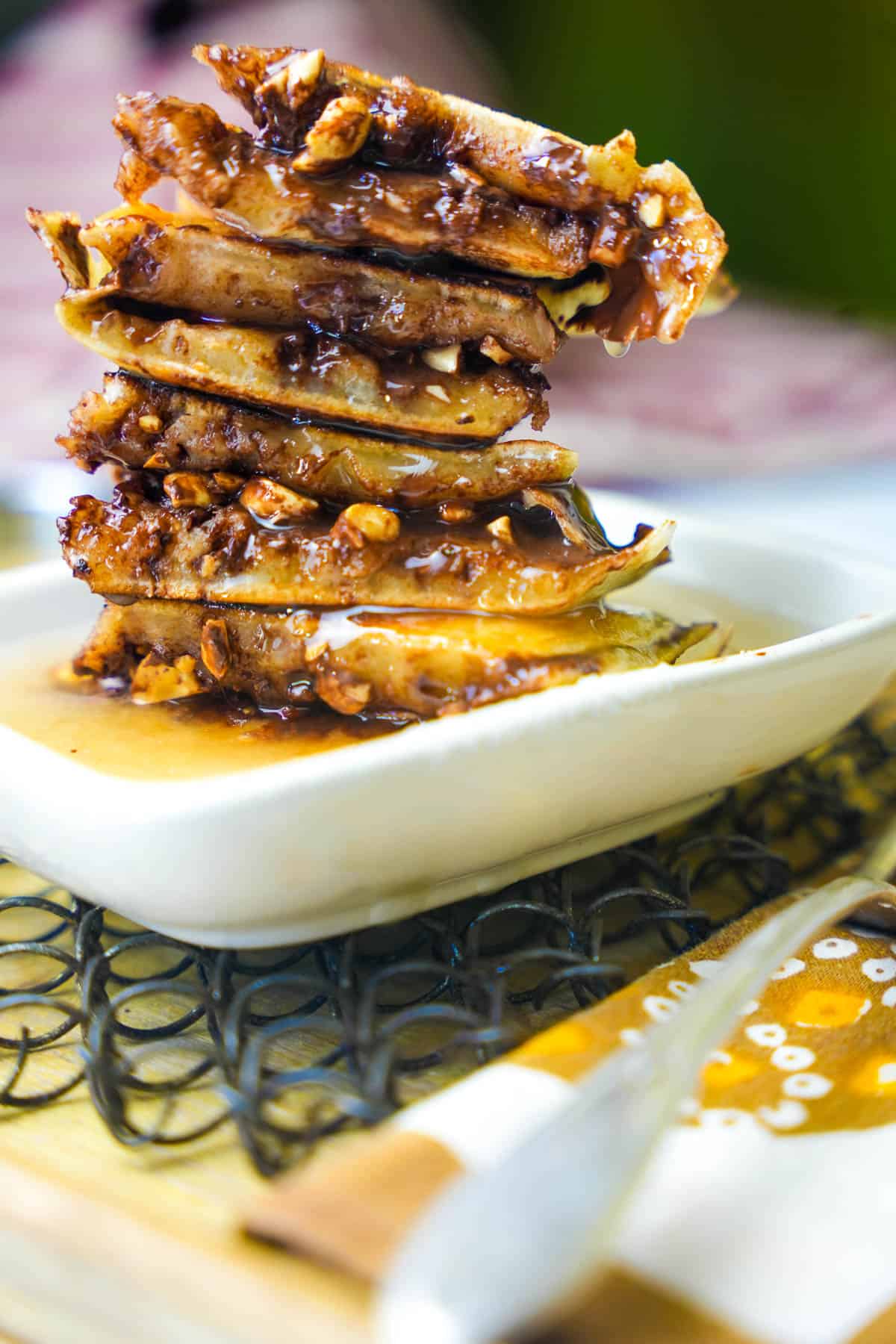


👩🍳 Learn to make the DOPEST desserts
This 5-day guide to the best vegan sweets I have ever made is 100% FREE, & you'll love the actual heck out of it 🥰
🤷♀️What is Martabak Manis?
Martabak Manis, also known as Terang Bulan or Apam Balik in some regions, is a beloved dish with a rich history and diverse origins. Its roots can be traced back to the streets of Southeast Asia, where it has become a popular street food delicacy.
Different from other pancakes (like these OUTSTANDING blue corn pancakes), Martabak is only cooked on one side, creating a fluffy steamed pancake body.
🧈 Indonesian Pancake Ingredients
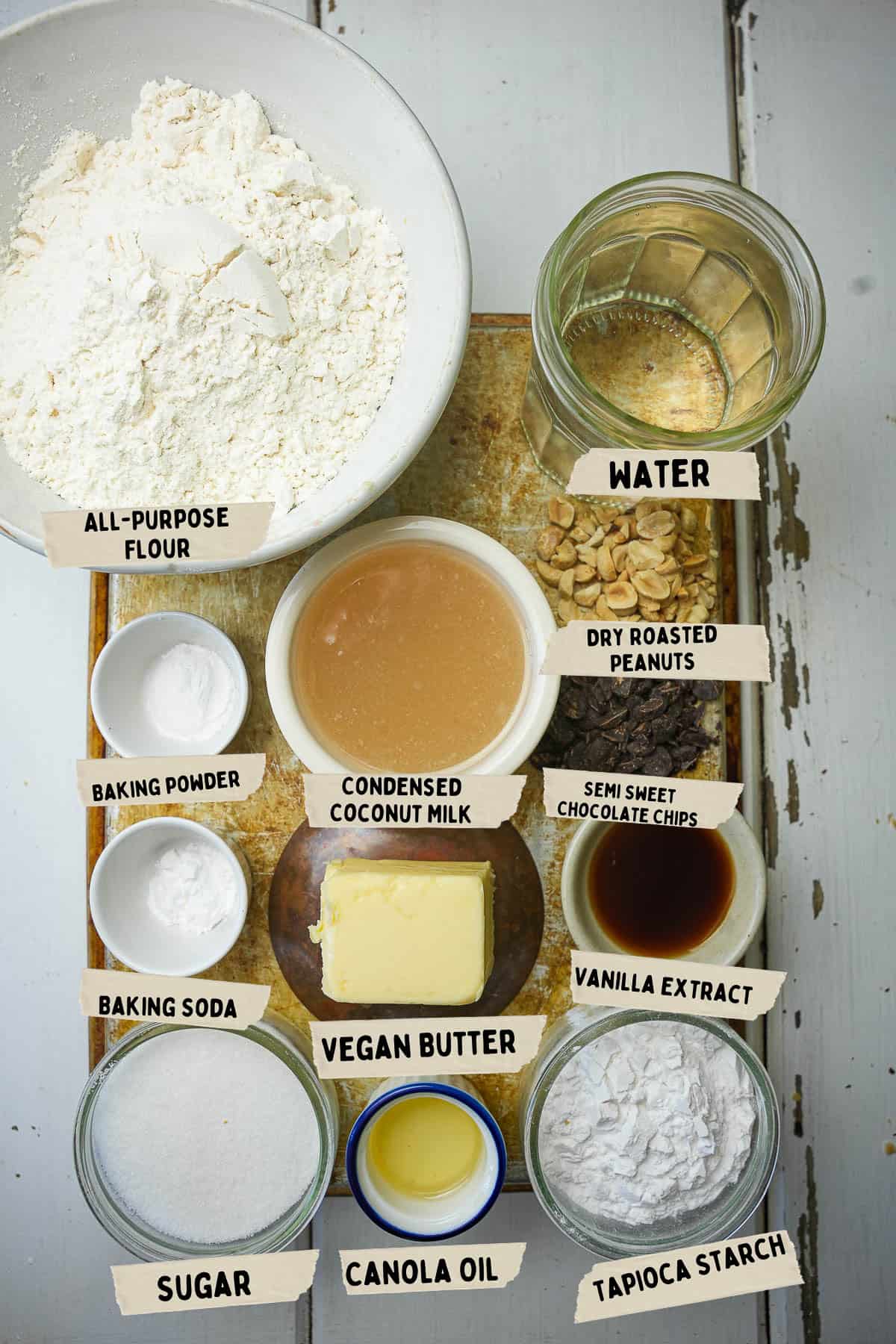
Tapioca starch
Tapioca starch, also known as tapioca flour is derived from cassava root, and is a versatile ingredient commonly used in cooking and baking. It is prized for its ability to add thickness, improve texture, and enhance the binding properties of various dishes, including desserts like Martabak Manis. If tapioca starch is not available, a suitable substitution would be cornstarch, or potato starch which share similar properties and can be used in a 1:1 ratio as a replacement.
Condensed coconut milk
Condensed coconut milk is a rich and creamy, slightly gooey ingredient widely used in both sweet and savory recipes, including this Vegan Martabak Manis! It is made by simmering coconut milk and sugar together until most of the water content evaporates, resulting in a thick, sweet, and indulgent product.
If condensed coconut milk is not readily available, a suitable substitution is condensed oat milk. Condensed oat milk offers an even creamier consistency and comparable sweetness.
Peanuts
Using unsalted dry roasted peanuts in the recipe for Vegan Martabak Manis adds a satisfying crunch and nutty flavor that complements the sweetness of the dish. The peanuts provide a delightful contrast in texture and a subtle hint of savory notes, enhancing the overall taste experience. You can swap them out for any other unsalted roasted nuts you might love more than peanuts, such as almonds, macadamia nuts, pistachios, or Brazil nuts.
Chocolate chips:
The vegan semi-sweet chocolate chips used in this recipe provide a decadent and rich chocolate flavor that contrasts the thick pancakes beautifully. When selecting chocolate for this recipe, opt for high-quality vegan chocolate chips that are made with natural ingredients and have a rich cocoa content (over 60%). Look for options that are labeled as "semi-sweet" or "dark" chocolate, as they will provide a balance of sweetness and intensity. if you have some on hand, you can use a vegan chocolate spread instead of the chips.
*See the recipe card at the bottom of the page for exact quantities, nutritional info, and detailed cooking directions.
📖 How to make martabak:
You wanna see how these fluffy golden chocolate stuffed clouds are born? I will walk you through the whole process. Or you can follow along with the easy-to-print recipe card towards the bottom of this page.
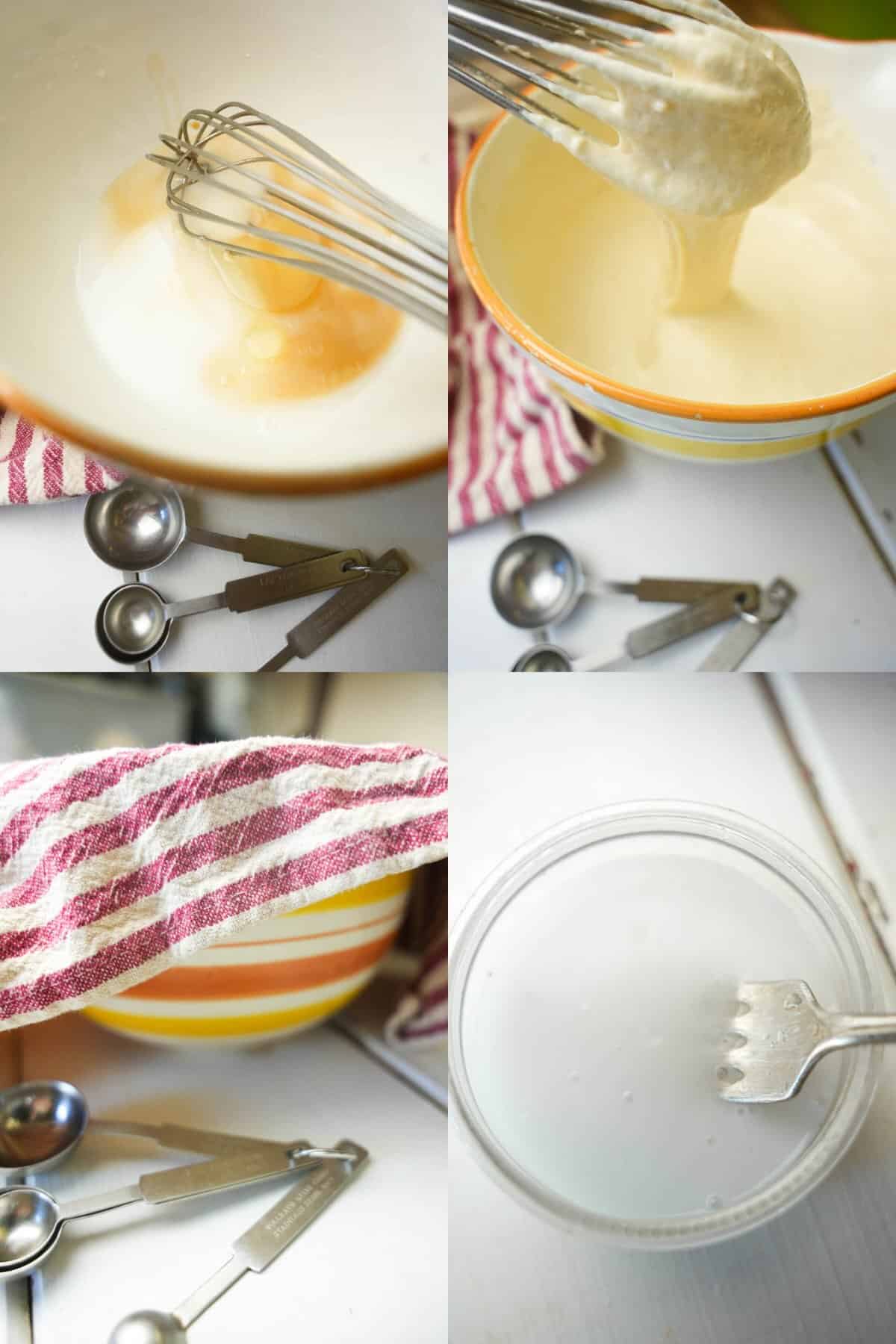
Step 1
In a mixing bowl, combine tapioca starch, water (or pandan juice), granulated sugar (or coconut sugar), canola or vegetable oil, and vanilla extract. Whisk until well combined. You can also mix this in a stand mixer fitted with the whisk attachment.
Step 2
Gradually add all-purpose flour while continuing to whisk until a smooth batter forms.
Step 3
Cover the batter and let it rest for one hour.
Step 4
AFTER ONE HOUR: In a separate small bowl, mix water, baking powder, and baking soda to create the leavening solution.
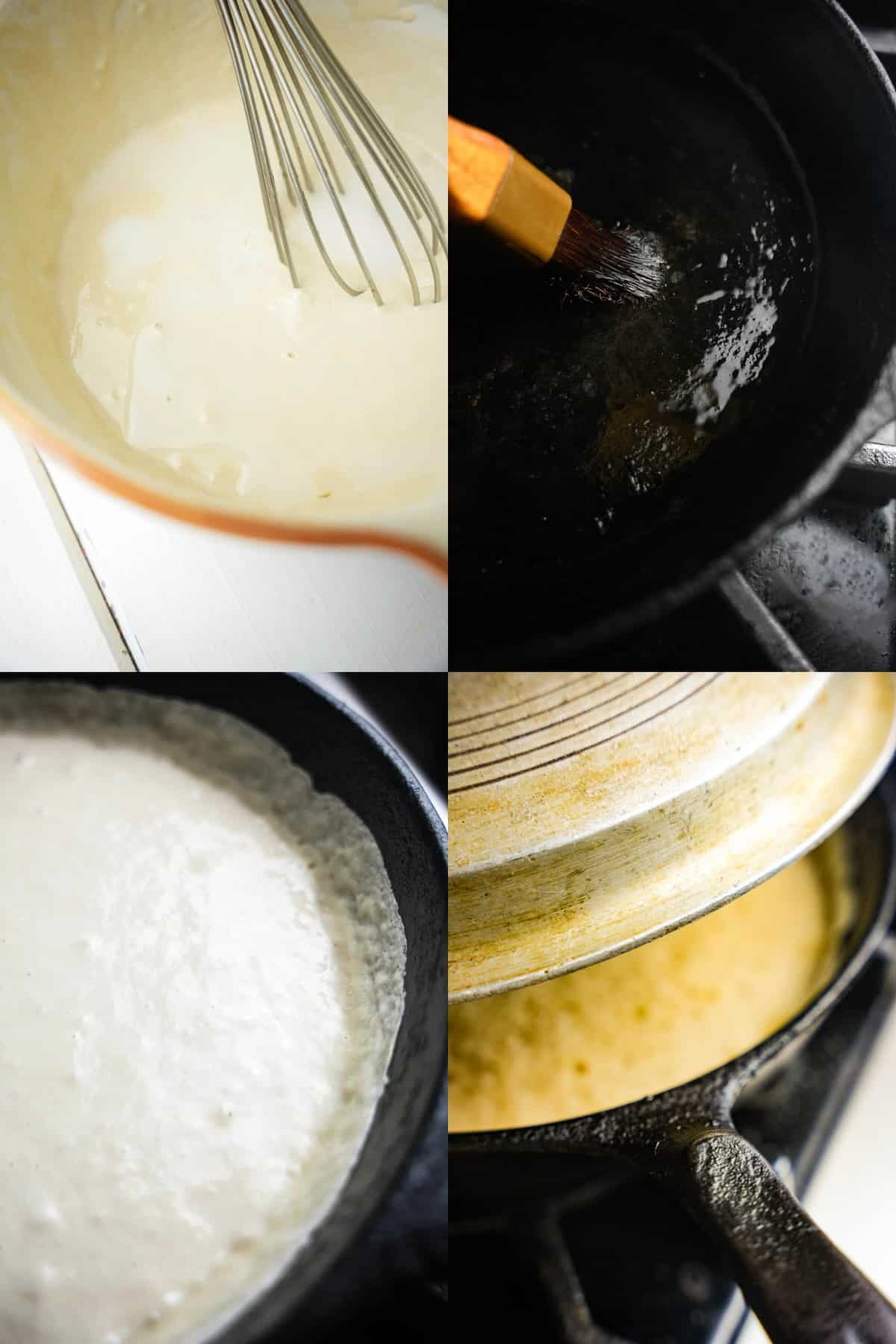
Step 5
Pour the leavening solution into the batter and whisk until fully incorporated.
Step 6
Heat a large non-stick pan over medium-low heat. If using a non-stick pan, you can skip adding vegan butter to grease the pan. Adjust the flame under the hot pan as needed to prevent burning while cooking the pancake.
Step 7
Carefully pour half of the batter onto the pan and quickly tilt the pan in a circular motion to spread the batter thinly, creating a crisp edge that extends about one inch (2.5 cm) up the side of the pan.
Step 8
Cover the pan with a lid and let the pancake steam for a couple of minutes until the surface starts to bubble but is still slightly wet looking. This helps create a light and fluffy texture.

Step 9
Sprinkle granulated sugar over the bubbling surface of the pancake to enhance the air bubbles and create a porous texture.
Step 10
When the center puffs and the batter is mostly set and no longer liquid-looking, uncover the pan and brush the surface of the pancake with vegan butter, ensuring even distribution. The melted butter will seem into the tiny pour of the pancake making it crazy rich!
Step 11
Sprinkle chopped semi-sweet chocolate chips onto the surface of the pancake (or carefully spread on vegan Nutella) and allow them to melt slightly as the pancake continues to cook for about 30 seconds. Be careful not to overcook the pancake to maintain a soft and fluffy texture.
Step 12
Transfer the Martabak Manis to a cutting board, sprinkle liberally with chopped peanuts, and fold one half of the pancake over, forming a half-circle sandwich. Allow the chocolate chips to melt slightly before folding the pancake to incorporate the chocolate.
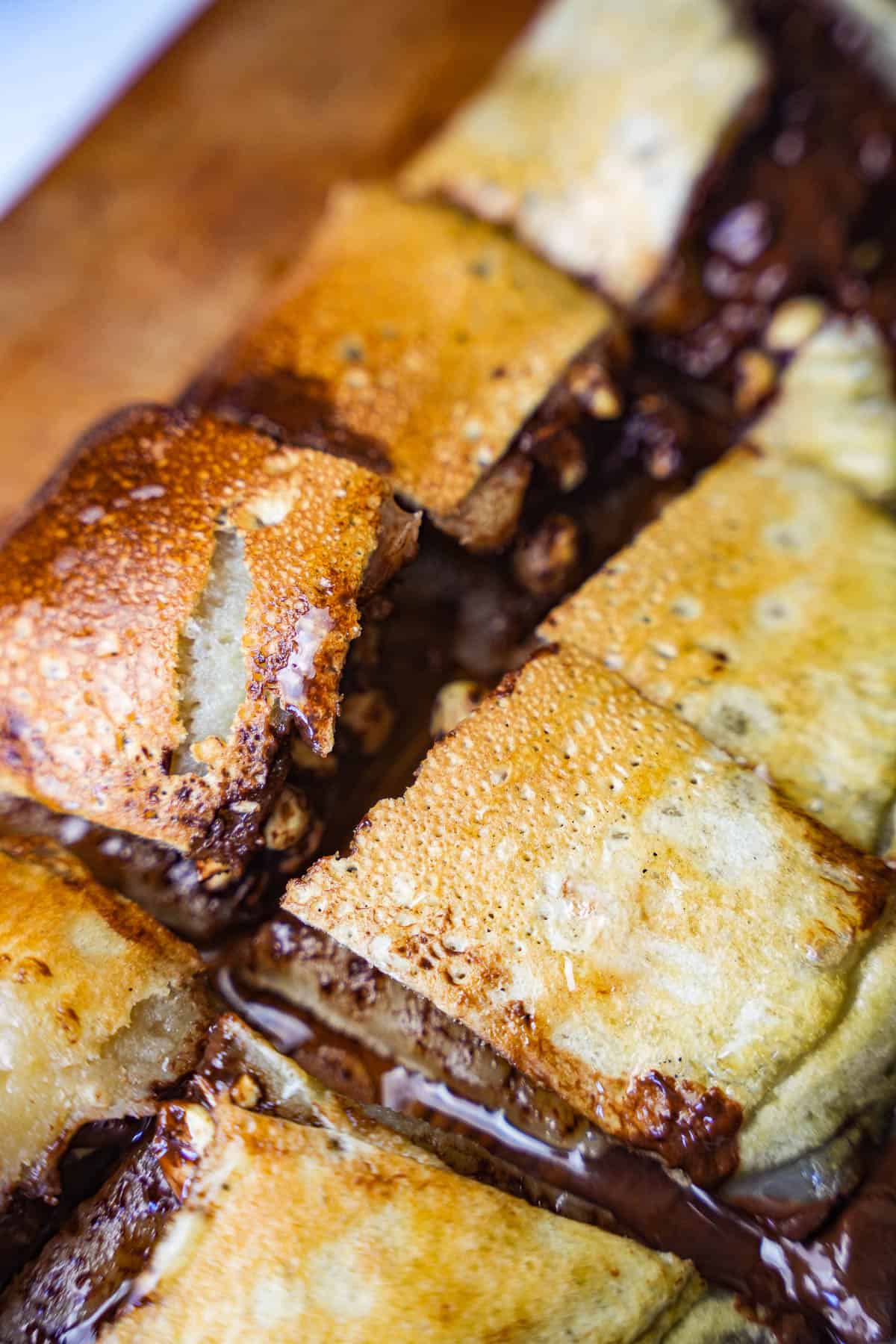
Step 13
Cut the folded pancake into square portions.
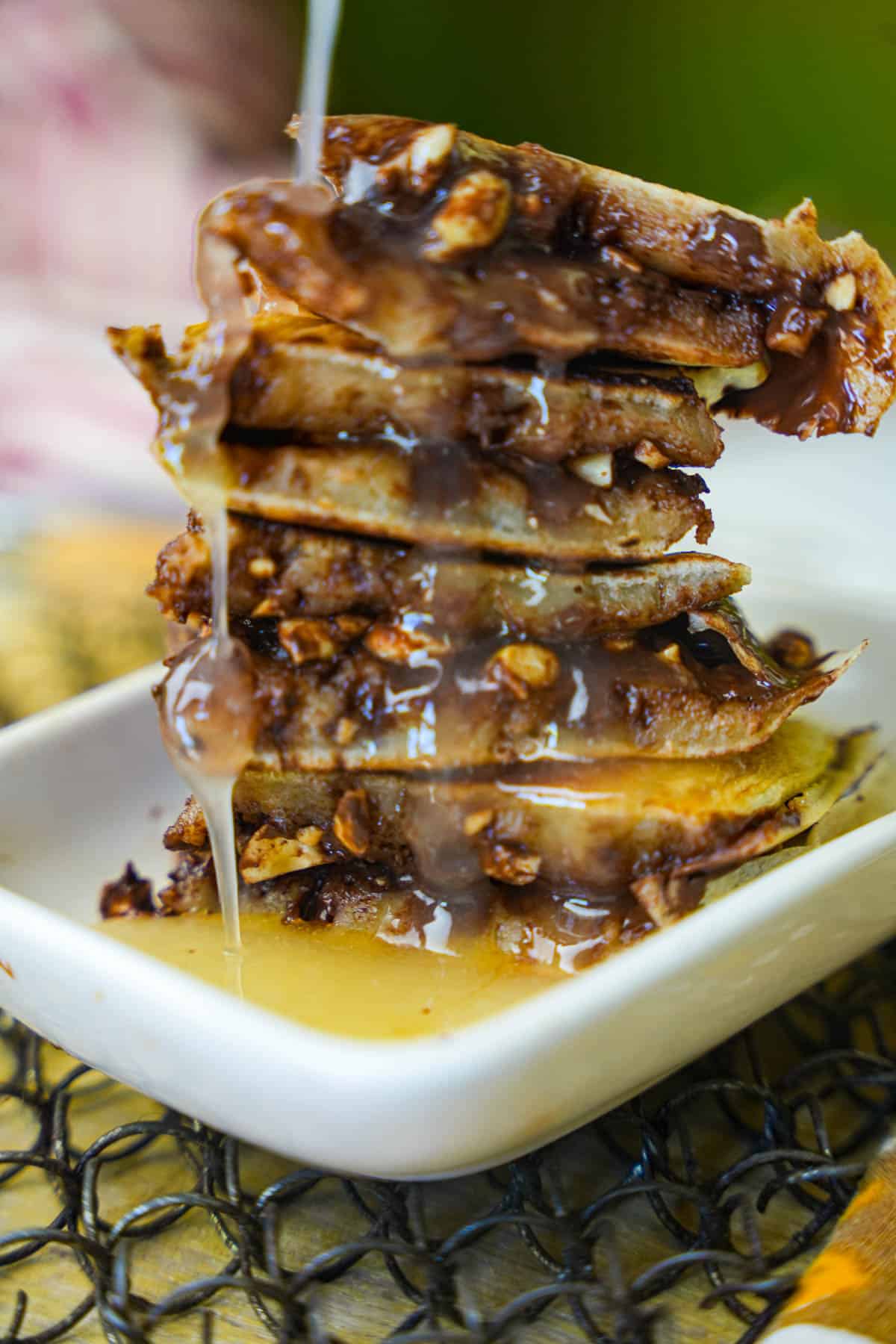
Step 14
Plate the portions and drizzle with condensed coconut milk, and garnish with more chopped peanuts for added crunch and flavor. Maybe a dollop of vegan whipped cream too if you are feeling frisky!
Repeat the process with the second half of the batter to make another few servings.
🥣The importance of autolyse
The autolyse stage, which involves letting the batter sit for an hour before adding the leavening agents, plays a significant role in the preparation of Martabak Manis. It is an important technique in baking that allows the flour to hydrate fully and certain chemical reactions to take place, resulting in a more desirable texture and flavor.
During the autolyse stage, the particles of flour in the batter absorb the liquid ingredients, such as water (or pandan juice if used), and form gluten. Gluten is the protein network in wheat that gives structure and elasticity to the pancake batter. Allowing the flour to fully hydrate enhances gluten development, leading to a more tender and fluffy pancake that is more likely to develop the desired honeycomb texture.
The autolyse stage also allows enzymes present in the flour to begin breaking down starches into simpler sugars. This process, known as amylase activity, helps develop flavor and aids in browning during cooking. Allowing the batter to rest results in a more complex flavor, and more evenly browned final product.
Furthermore, when you let the batter rest, the flour particles fully absorb the liquid, resulting in a more consistent batter. This helps in achieving a uniform texture throughout the pancake, ensuring that it cooks evenly and attains the desired lightness and fluffiness.
After the autolyse stage, the leavening agents, baking powder and baking soda, are added to the batter in a liquid slurry. These agents react with the moisture, heat, and acids present in the batter, producing carbon dioxide gas. The gas is responsible for the formation of air pockets and the creation of the honeycomb bubble pattern, contributing to the fluffy texture of Martabak Manis.
🍽️Serving Ideas
Want to fit this into a Southeast Asian feast?
Serve martabak as the perfect dessert after enjoying flavorful dishes such as Nasi Uduk, Ketoprak, thick Bami Goreng, sweet and savory Mee Goreng.
A classic meal to have these for dessert after is Sayur Lodeh topped with lontong. It goes great following Filipino dishes like this DOPE charred eggplant salad with green mango, or crispy tofu sisig.
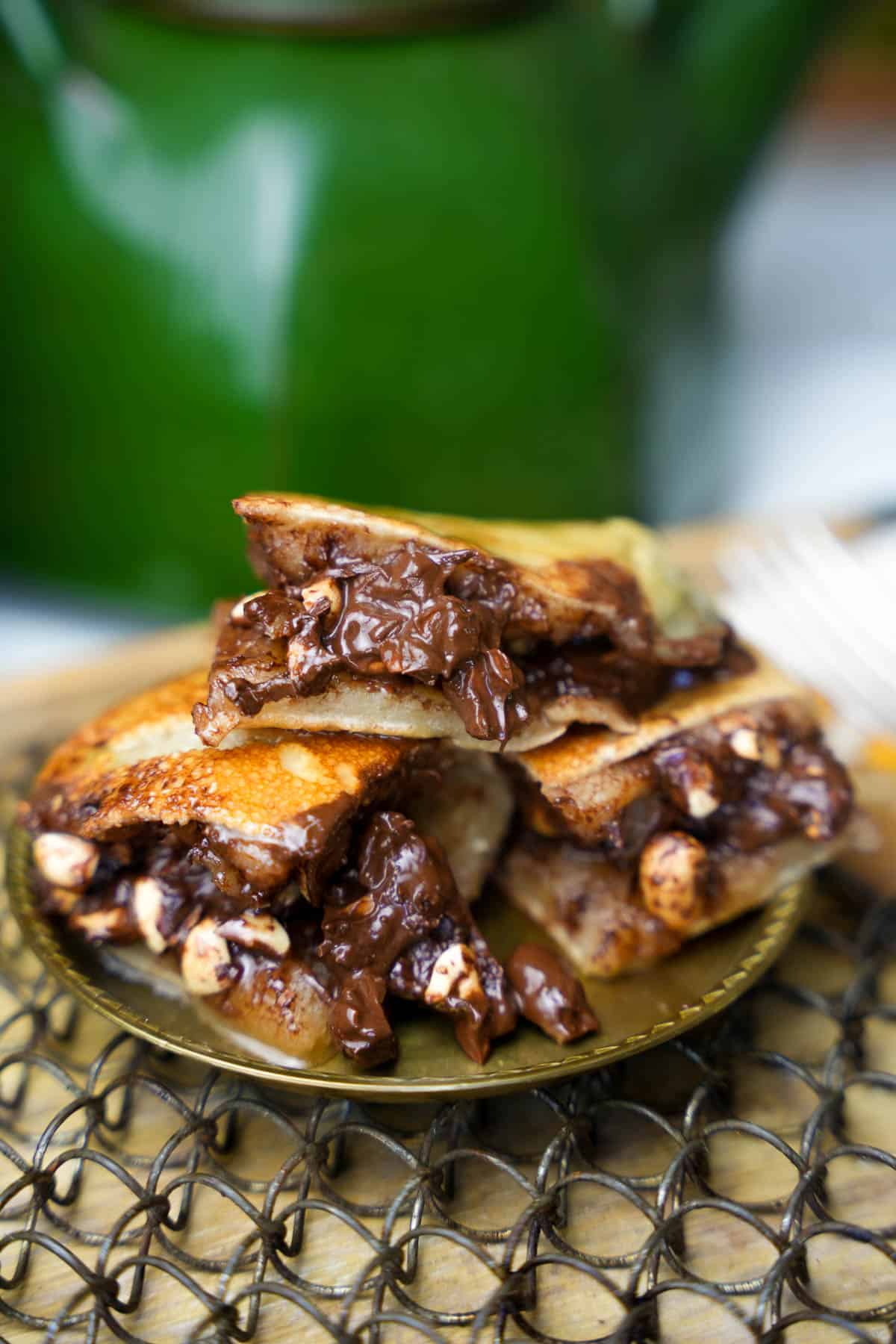
🥞 The savory long distant roots of Martabak
Martabak has its origins in the Middle East, particularly in Yemen, where it is known as "Murtabak." It was traditionally a savory stuffed pancake, filled with a mixture of meat, onions, and spices. As it traveled across trade routes, it underwent various transformations and adaptations, eventually giving birth to Martabak Manis as we know it today.
Martabak Manis made its way to Indonesia, Malaysia, Singapore, and other neighboring countries, where it was warmly embraced and incorporated into the local culinary fabric. Over time, it underwent regional variations and acquired unique characteristics in each country.
In Indonesia, Martabak Manis became an iconic street food, particularly in the cities of Jakarta and Bandung. It evolved into a sweet version, featuring a thick, fluffy pancake base with various fillings and toppings. The fillings often include chocolate, cheese, peanuts, condensed milk, and other delectable ingredients, creating a symphony of flavors and textures.
In Malaysia and Singapore, Martabak Manis is known as "Apam Balik." It retains the sweet nature of the Indonesian version but is typically thinner and folded into a half-moon shape. The fillings may vary, including crushed peanuts, sugar, corn, or even sweetened creamed corn.
🤷♀️Recipe FAQs
Martabak Bangka and Martabak Manis are fascinating Indonesian delicacies with distinct culinary identities. Hailing from the Bangka Belitung Islands, Martabak Bangka showcases a unique interplay between a pancake and a cake. Its generous thickness and dense, cake-like texture set it apart. This delectable treat features a luscious medley of fillings, including chocolate, cheese, and peanuts, enveloped within its folds. The resulting creation is a delectably thick, crispy, and indulgent dessert, beloved for its rich flavors and satisfying mouthfeel.
In contrast, Martabak Manis, also referred to as Terang Bulan, exhibits a lighter and more delicate nature. This delightful pancake variation delights with its airy and fluffy texture. The batter, typically a blend of all-purpose flour, water, sugar, and other secret ingredients, is skillfully spread on a griddle. Sweet fillings like chocolate, cheese, or condensed milk are artfully placed before the pancake is deftly folded in half. The result is a thin, tender pancake that encapsulates the enticing sweetness of the fillings.
Autolysing a dough or batter involves letting it rest for a certain period to allow the flour to hydrate fully and develop gluten naturally. While autolysing is a beneficial technique, allowing the dough to autolyse for an excessively long time can have some drawbacks.
If you autolyse the dough for several hours or overnight at room temperature, there is a risk of over-fermentation.
During an extended autolyse, enzymes naturally present in the flour start breaking down the starches into sugars. This process can lead to excessive fermentation and the production of excess carbon dioxide, resulting in overproofed dough. The dough may become overly sticky, lose its structure, and become difficult to handle.
Furthermore, an extended autolyse can eventually weaken the gluten structure in the dough. Gluten development is crucial for providing elasticity and structure to baked goods. If the dough is left to autolyse for too long, the gluten strands can break down, leading to a weaker structure and a less desirable texture in the final product.
Stick to the one-hour resting time in this recipe, and you will be fine.
Martabak Manis
Martabak Manis, AKA Min Jiang Kueh is a thick and sweet pancake dish found throughout Indonesia and Malaysia, and the one you are staring at a meticulously crafted recipe for! It features a pancake base cooked in a covered pan with a fluffy and chewy texture, and it's filled with a variety of sweet fillings. The fillings can range from chocolate and grated cheddar cheese (I know it sounds sorta strange, but try it with your favorite shredded vegan cheese melted on one side, it’s kinda amazing) to condensed milk (I use coconut or oat-based condensed milk) and chopped nuts. The thick pancake is typically folded or rolled and topped with additional sweet condiments such as powdered sugar or drizzles of chocolate syrup.
Martabak Telur
Savory Martabak Telur, on the other hand, is a savory variant that showcases the savory side of this dish. It often consists of a thinner, crepe-like pancake cooked in a large flat frying pan, that is filled with a mixture of beaten duck eggs, minced meat (commonly beef or chicken), onions, herbs, and spices.
You can make it vegan using scrambled tofu with diced potatoes and green onions, or “JUST EGG” with some pulled jackfruit, or stir fried seitan (I have a great vegan chicken recipe you might dig for that). The filling is spread evenly over the pancake and then folded into a square or rectangular shape. Instead of condensed milk, savory Martabak Telur is typically served with a side of tangy and spicy dipping sauce, adding a burst of flavor to the savory pancake. I garnish this style of martabak with sesame seeds, and serve it with my Korean BBQ Sauce on the side, and it’s a gosh darned sliced-green-onions-topped-pancake-dream-come-true.
These thick sweet pancakes are cooked only on one side, partially by steaming as the pan is covered. The “honeycomb” bubble pattern that forms as the pancake cooks is an essential characteristic of fluffy Martabak Manis. When preparing the batter, after a one-hour resting period, baking powder and baking soda are added. These agents release carbon dioxide gas when they come into contact with moisture and heat during the cooking process.
As the pancake batter is poured onto the griddle, the gas bubbles trapped within the batter expand, creating a distinctive honeycomb-like structure. As the bubbles reach the surface, when the batter is just about half cooked, sugar is sprinkled on, and the particles of sugar help open the bubbles, leaving a pathway for the fillings to become absorbed into the pancake.
The fluffy and porous nature of the pancake allows the fillings to penetrate into the crevices, creating a delicious interplay of tastes and textures. For example, if chocolate is used as a filling, the heat from the pancake helps melt the chocolate, infusing every bite with its luscious richness. Similarly, ingredients like condensed milk, chopped peanuts, or other sweet or savory fillings interact with the pancake, enhancing its flavor profile and creating a delectable synergy.
The trick is getting the cooking temperature just right so that the thick pancake achieves the classic chewy texture, and golden brown color on the bottom, without burning. In my cast iron skillet, I set the flame a little shy of medium, and they cook perfectly.
✌️Like Martabak? You'll love these:
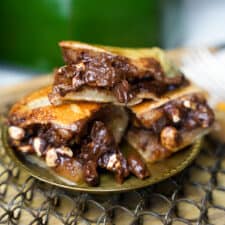
Martabak Manis- Indonesian pancakes with chocolate and peanuts
Ingredients
Batter
- ¼ cup tapioca starch
- 1 ⅔ cup water or pandan juice
- ¼ cup granulated sugar or coconut sugar
- 2 teaspoons canola oil or vegetable oil
- 1 ½ teaspoon vanilla extract
- 2 ⅓ cups all-purpose flour
Leavening solution
- ¼ cup water
- 1 teaspoon baking powder
- ½ teaspoon baking soda
Toppings
- ⅓ cup vegan butter room temperature
- 2 tablespoons granulated sugar or to taste
- ⅓ cup condensed coconut milk or condensed oat milk
- ½ cup roughly chopped semi-sweet chocolate chips
- ½ cup chopped unsalted dry roasted peanuts
Instructions
- In a mixing bowl, combine tapioca starch, water (or pandan juice), granulated sugar (or coconut sugar), canola, or vegetable oil, and vanilla extract. Whisk until well combined.
- Add all-purpose flour gradually while continuing to whisk until a smooth batter forms.
- Allow the batter to rest for 1 hour, covered, to undergo the autolyse stage.
- After the autolyse, in a separate small bowl, mix water, baking powder, and baking soda to create the leavening solution.
- Pour the leavening solution into the batter and whisk until fully incorporated.
- Heat a large non-stick pan over just-slightly-lower-than-medium heat. Add a tiny amount of vegan butter to the pan if you are not using a non-stick pan.
- Pour a big ladleful of batter (about half of the batter you mixed) onto the pan and quickly tilt the pan in a circular motion to spread the batter thinly and create a crisp edge that extends about one inch (2.5 cm) up the side of the pan.
- Cover the pan with a lid and let the pancake steam for a couple of minutes until the surface starts to bubble but is still a little wet looking.
- Sprinkle granulated sugar over the bubbling surface of the pancake to help open up the bubbles and create the porous honeycomb texture.
- Once the batter is mostly set up and is no longer liquid looking, uncover the pan and brush the surface of the pancake with vegan butter, ensuring it is evenly distributed.
- Sprinkle chopped semi-sweet chocolate chips onto the surface of the pancake and allow them to melt slightly as the pancake continues to cook for 30 seconds.
- Transfer the Martabak Manis to a cutting board, sprinkle liberally with chopped peanuts and fold one half of the pancake over, forming a half circle sandwich.
- Cut into square portions.
- Plate the portions and drizzle with condensed coconut milk and garnish with more chopped peanuts for added crunch and flavor.
- Repeat the process with the second half of the batter to make another few servings.
Notes

Enter your email & I'll send it to your inbox. Plus, get great new recipes from me every week!
By submitting this form, you consent to receive emails from Cinnamon Snail.

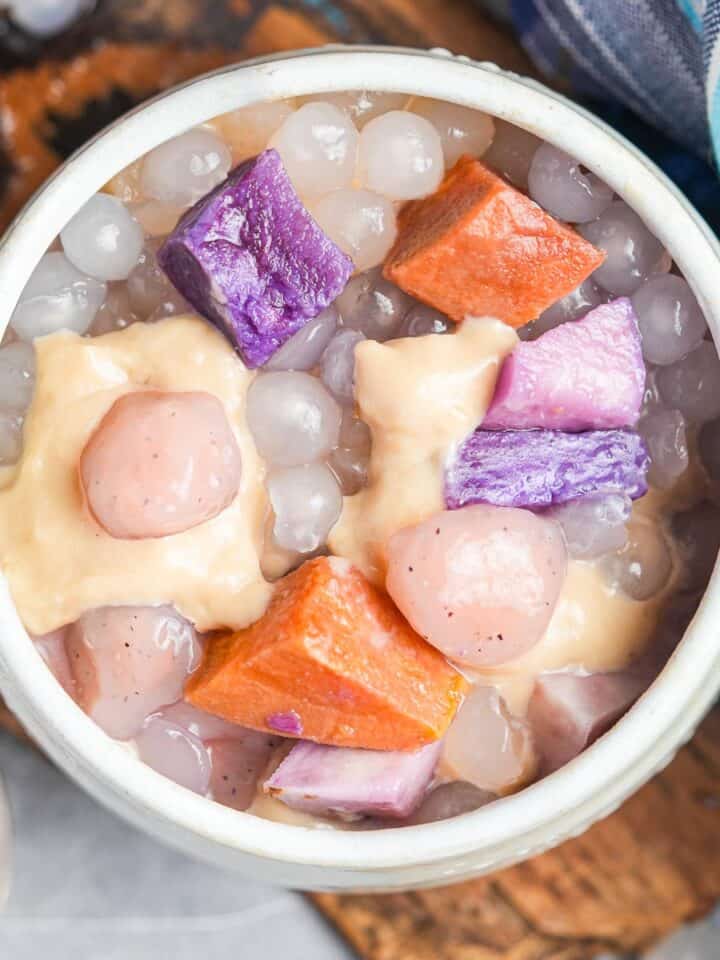


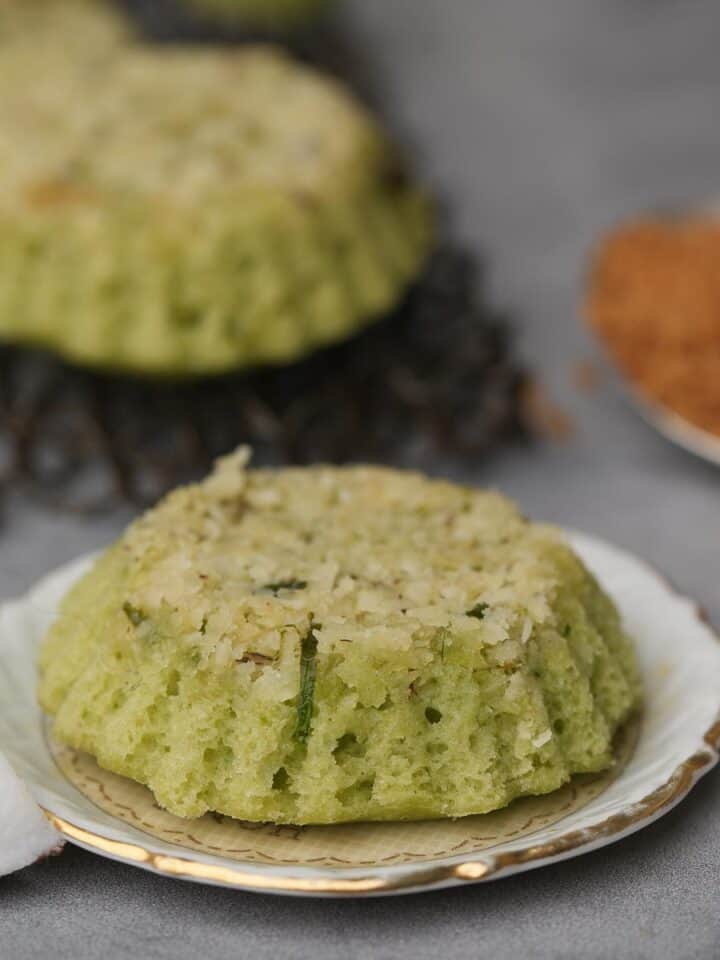


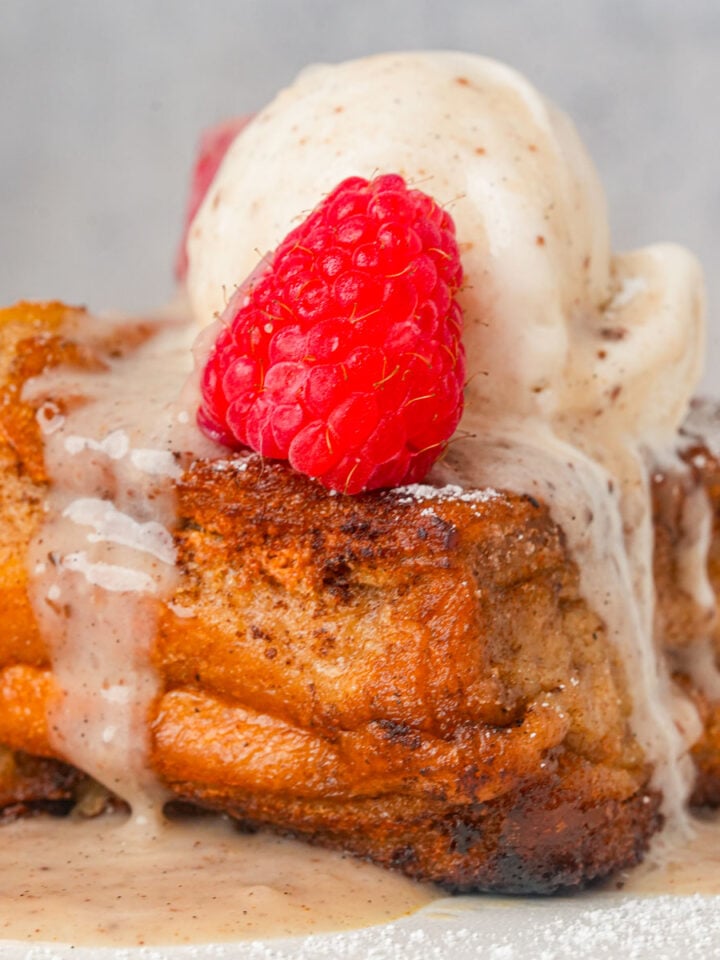



HG says
Great recipe! One of those kinda recipes where you have just about everything in the house to make it. Simple, quick and delicious. Even passed my wife's taste test, and she can be picky.
Maya says
I loved this recipe! I will add one note, though -- if your stove has a "power burner" or a burner that heats up faster/hotter than the others, you will need to set the temp to low instead of just-below-medium. I made the first batch on 4 (out of max 8) setting and completely burnt the pancake. Once I turned it down to a 2 out of 8, it came out perfectly golden.
Otherwise, this recipe is so tasty and I love it! The chewy texture is very satisfying and less dry than a regular pancake. Plus, who doesn't love chocolate 🤤😋🤩
Adam Sobel says
Ooh! Thanks for sharing that tip. I just use a regular stove so I am not always hip to these details. Def finding the perfect temperature varies on a stove-by-stove basis, because they all put out slightly different BTUs or power. Glad you loved 'em <3
Cheryl says
Sweet crunchy absolute deliciousness! Easy to put together yet a really nice little plate of goodness!